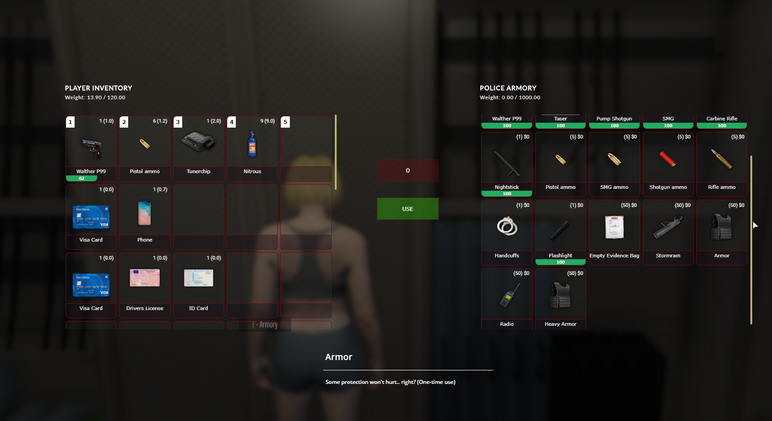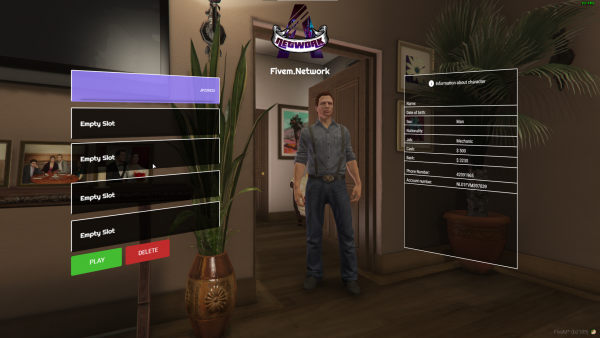Ok, parlons de QBCore et QBus. Si vous aimez les serveurs de jeu de rôle FiveM, en particulier ceux qui se targuent de la personnalisation, vous avez probablement entendu parler de ces noms. Vous vous demandez peut-être même : est-ce la même chose ? Quel est le problème ? Dissipons la confusion.
De ESX à QBus, puis QBCore
Pour comprendre la relation entre QBCore et QBus, nous devons revenir un peu en arrière. Tout a commencé avec ESX, ou « ES Extended ». ESX était l’un des premiers et des plus populaires frameworks pour la création de serveurs de jeu de rôle FiveM. Il a changé la donne, facilitant l’ajout de fonctionnalités personnalisées.
Mais comme tout, ESX avait ses limites. C'est là qu'intervient QBus. QBus était essentiellement une évolution d'ESX, conçue avec l'idée d'être plus efficace et plus flexible. Il a repris les concepts de base d'ESX et les a améliorés.
Aujourd'hui, QBCore entre dans le ring. QBCore est, à bien des égards, un descendant direct de QBus. Il s'appuie sur le framework de QBus et est devenu un choix populaire pour les propriétaires de serveurs qui souhaitent une expérience hautement personnalisable.
Alors, QBCore est-il simplement une nouvelle image de marque de QBus ?
C'est là que ça devient intéressant. La réponse courte est : c'est compliqué.
QBCore n'est pas simplement un changement de marque. C'est plutôt une sorte de bifurcation, une branche sur la route. Les développeurs de QBCore ont pris le Cadre QBus et ils ont construit dessus, ajouté de nouvelles fonctionnalités, amélioré les performances et structuré le framework de manière à le rendre plus facile à utiliser. Ainsi, bien que QBCore ait ses racines dans QBus, il a son propre chemin distinct.
Différences clés entre QBCore et QBus
Très bien, entrons dans les détails. Voici ce qui différencie QBCore et QBus :
- Structure et organisation:QBCore a été conçu pour être plus modulaire et organisé. Il est plus facile pour les développeurs de trouver et de modifier des fonctionnalités. Pensez-y comme ceci : si QBus était une boîte à outils désordonnée, QBCore est une boîte à outils bien organisée.
- Performance:L'un des objectifs principaux de QBCore était d'améliorer les performances. Ils ont rationalisé le code sous-jacent pour le rendre plus efficace, ce qui signifie moins de lag sur les serveurs pour les joueurs.
- Soutien communautaire:QBCore a bâti une communauté solide autour de lui. Cela signifie plus de ressources, de tutoriels et d'assistance pour les propriétaires de serveurs et les développeurs.
- Développement actif:QBCore est devenu le plus activement développé des deux, avec des mises à jour régulières, des correctifs et de nouvelles fonctionnalités.
- Personnalisation:Bien que les deux soient personnalisables, l’implication de la communauté dans QBCore a donné lieu à une multitude de scripts et d’ajouts personnalisés qui sont facilement disponibles.
Pourquoi tout cela est-il important ?
Si vous jouez simplement sur un serveur, cela peut sembler sans importance. Mais comprendre la différence peut vous donner un aperçu de ce qui est possible avec chaque framework :
- Pour les joueurs:Comprendre qu'un serveur utilise QBCore signifie qu'il est susceptible d'avoir une meilleure personnalisation et qu'il fonctionne, espérons-le, avec des performances solides.
- Pour les propriétaires de serveurs:Le choix entre QBCore et QBus (si c'est encore un choix) déterminera en grande partie la facilité et l'efficacité avec lesquelles vous pourrez construire et entretenir votre serveur.
- Pour les développeurs:Si vous créez des scripts, savoir quel framework exécute le serveur vous aide à savoir comment développer et également à savoir s'il sera compatible.
Le verdict : est-ce la même chose ?
Donc, pour résumer, QBCore n'est PAS QBus, mais il ne serait pas là sans lui. QBCore a évolué à partir de QBus, en prenant la base et en l'améliorant pour créer un framework moderne et performant. Ils partagent un certain ADN, mais ils sont devenus des entités distinctes avec des priorités et des trajectoires différentes.
FAQ
- QBCore est-il meilleur que QBus ?
- Dans la plupart des cas, oui. QBCore offre généralement de meilleures performances, plus de fonctionnalités et un développement actif.
- Puis-je facilement migrer de QBus vers QBCore ?
- C'est possible, mais ce n'est pas simple. C'est une tâche de grande envergure, car il y a peu de compatibilité entre les deux. Vous devrez probablement tout reconstruire à partir de zéro.
- Où puis-je trouver des ressources pour le développement de QBCore ?
- La communauté QBCore sur GitHub et Discord sont de bons points de départ.
- Existe-t-il encore des serveurs fonctionnant sur QBus ?
- Oui, mais ils sont rares de nos jours et ne sont pas aussi activement maintenus que les serveurs QBCore.
QBCore est devenu un framework de premier plan pour les serveurs FiveM. Connaître ses origines et son évolution d'ESX à QBus donne une bonne base de compréhension, ainsi qu'un aperçu de la manière dont il continue d'être l'un des meilleurs frameworks disponibles.
Récapitulatif : le chemin évolutif
Avant d'aborder les fonctions et le code, revisitons rapidement l'arbre généalogique. Nous avons commencé avec ESX, qui était comme le modèle T des frameworks FiveM – innovant pour l’époque, mais maladroit par rapport aux normes modernes. Puis est arrivé QBus, essayant d’être le meilleur ESX. Puis est arrivé QBCore, comme la voiture étant une super voiture entièrement personnalisable.
QBus a tenté de rationaliser la base de code ESX, en se concentrant sur les performances et en simplifiant un peu le processus de configuration du serveur. Mais il présentait toujours des limites, notamment à mesure que la personnalisation du serveur devenait plus complexe. QBCore a reconnu ces limites et s'est efforcé de créer un meilleur framework à utiliser.
Différences architecturales fondamentales : les frameworks sous le capot
La véritable divergence entre QBCore et QBus réside dans leur architecture. Voici une description détaillée de leurs différences :
- Modularité: QBCore a une conception beaucoup plus modulaire que QBus. Pensez-y comme à des Lego : chaque système (inventaire, emplois, logements, etc.) est un bloc séparé qui peut être facilement échangé ou modifié, sans affecter les autres parties du jeu. QBus ressemblait un peu plus à un modèle unique et complexe, où les changements dans un domaine causaient souvent des problèmes ailleurs.
- Gestion des événements:Les deux frameworks s'appuient fortement sur les événements pour communiquer entre les scripts, mais QBCore a amélioré cette communication. Ils peuvent transmettre des données plus complexes de manière efficace, de sorte que les scripts peuvent mieux réagir aux événements du jeu.
- Gestion des données:QBCore a introduit des structures de données et des systèmes de gestion robustes. Il est conçu pour l'évolutivité et un traitement plus efficace des données, des interactions des joueurs aux propriétés des objets.
- Style de code: QBCore encourage un style de codage plus propre et plus organisé. Cela permet aux développeurs de contribuer et de modifier plus facilement le code, et signifie que vous pouvez ajouter de nouveaux développeurs à vos projets en passant moins de temps à comprendre ce qui se passe.
Systèmes clés et exemples
Prenons quelques exemples concrets. Comment ces frameworks gèrent-ils certaines fonctionnalités de base ?
Gestion des stocks
QBus:Le système d'inventaire de QBus était une extension de base d'ESX, nécessitant souvent plusieurs mises à jour pour gérer de grands inventaires, et causait parfois même des problèmes et des erreurs lorsque trop d'éléments se trouvaient dans un inventaire.
QBCore:Le système de QBCore est plus avancé. Il utilise une configuration de base de données robuste pour les articles, avec la possibilité d'avoir des métadonnées, comme la durabilité, les numéros de série, etc. Il utilise également un système efficace pour charger et décharger les données d'inventaire et est plus rapide pour envoyer des données aux clients.
Systèmes d'emploi
QBus:Avec QBus, le système de tâches était fonctionnel, mais nécessitait beaucoup d'efforts pour les tâches et les rôles complexes. Il offrait un support limité pour des éléments tels que la création d'éléments au sein d'une tâche, et la progression complexe des tâches était problématique.
QBCore:QBCore est doté d'un système de tâches plus sophistiqué. Il a été conçu dès le départ pour être plus modulaire et adaptable. Il dispose d'outils permettant de créer des tâches personnalisées, avec différentes structures de classement, des échelles de rémunération et même la possibilité de créer des éléments personnalisés.
Personnalisation des personnages
QBus:La personnalisation des personnages était similaire à celle d'ESX, avec des options limitées pour ajouter de nouvelles fonctionnalités ou enregistrer des données complexes, elle nécessitait souvent des solutions de contournement pour gérer le processus.
QBCore:C'est là que QBCore se démarque vraiment, avec sa capacité à stocker et à charger des ensembles de données complexes. La personnalisation des personnages est plus polyvalente, permettant une plus large gamme d'options, telles que des tatouages, des accessoires et des vêtements uniques.
Gestion des événements et communication des scripts
QBus:Les événements de base étaient utilisés, mais il manquait certaines fonctionnalités clés lors du déplacement de grands ensembles de données entre les clients et les serveurs.
QBCore:Le système d'événements est conçu pour être efficace et évolutif. Il gère efficacement les événements personnalisés, ce qui rend la communication en temps réel entre différents systèmes plus robuste.
Pourquoi QBCore est-il plus populaire ?
D'accord, alors pourquoi QBCore est-il devenu la force dominante dans le monde du jeu de rôle FiveM ? Cela est dû à plusieurs facteurs :
- Développement actif:Il est activement développé, avec des corrections de bugs, de nouvelles fonctionnalités et des optimisations en cours de déploiement.
- Soutien communautaire:La communauté est immense. Il existe une multitude de scripts personnalisés et vous trouverez plus facilement de l'aide.
- Design moderne:La conception plus moderne et plus efficace a permis d'améliorer les performances et de rendre l'expérience de jeu plus agréable.
- Personnalisation:La conception modulaire et extensible signifie que les propriétaires de serveurs peuvent créer les serveurs de leurs rêves.
- QBus a été abandonné en 2021
L'avenir des frameworks FiveM
Ainsi, à mesure que QBCore continue d'évoluer, l'écart entre lui et d'autres frameworks plus anciens comme QBus ne fera que se creuser. Les frameworks qui ne sont pas constamment mis à jour deviendront obsolètes très rapidement.
FAQ – Aller plus loin
- QBCore nécessite-t-il plus de ressources pour fonctionner ?
- Pas nécessairement. Grâce aux optimisations, les serveurs utilisant QBCore peuvent être très efficaces.
- Puis-je utiliser des scripts QBus avec QBCore ?
- Dans la plupart des cas non, en raison de la façon dont ils gèrent les données, ils ne seront pas compatibles, vous devrez probablement trouver des équivalents ou réécrire les scripts.
- QBCore est-il difficile à apprendre pour les développeurs ?
- La conception modulaire de QBCore facilite l'apprentissage, par rapport aux anciens frameworks, car vous pouvez travailler sur les composants individuellement.
- L’utilisation de QBCore présente-t-elle des inconvénients majeurs ?
- L’inconvénient majeur est qu’il est plus complexe que certains frameworks plus simples, mais cela s’accompagne des avantages de davantage d’options et de fonctionnalités.
QBCore est une évolution majeure en termes de conception, de fonctionnalités et de communauté. Si vous vous demandez encore quelle est la différence, c'est un peu comme demander si une voiture moderne est la même qu'une très ancienne. Oui, ils ont tous les deux des roues, mais c'est là que s'arrêtent les similitudes.






